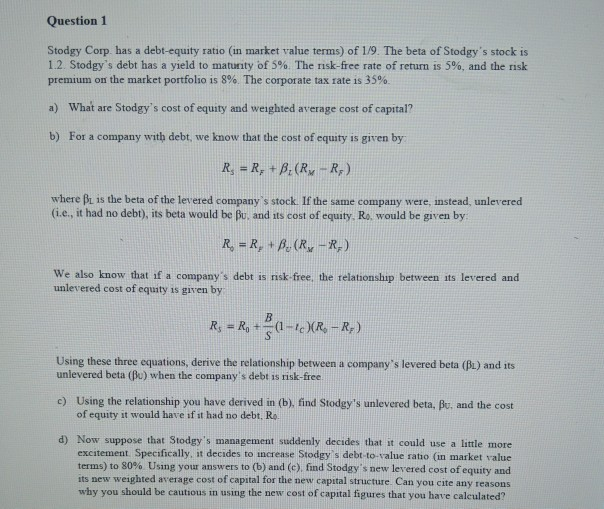Answered step by step
Verified Expert Solution
Question
1 Approved Answer
Question 1 Stodgy Corp has a debt-equity ratio (in market value terms) of 1/9. The bea of Stodgy's stock is 1.2. Stodgy's debt has a

Question 1 Stodgy Corp has a debt-equity ratio (in market value terms) of 1/9. The bea of Stodgy's stock is 1.2. Stodgy's debt has a yield to maturity of 5%. The risk-free rate of return is 5%, and the risk premium on the market portfolio is 8%. The corporate tax rate is 35% a) What are Stodgy's cost of equity and weighted average cost of capital? b) For a company with debt, we know that the cost of equity is given by R = R, + B2 (Ry-R) where Bu is the beta of the levered company's stock. If the same company were, instead, unlevered (i.e., it had no debt), its beta would be Bu, and its cost of equity. Ro. would be given by R = R + B. (R-R) We also know that if a company's debt is risk-free, the relationship between its levered and unlevered cost of equity is given by E R -R, +(1-1)(R-R) Using these three equations, derive the relationship between a company's levered beta (Bu) and its unlevered beta (u) when the company's debt is risk-free c) Using the relationship you have derived in (b), find Stodgy's unlevered beta, Bu, and the cost of equity it would have if it had no debt, Ro d) Now suppose that Stodgy's management suddenly decides that it could use a little more excitement. Specifically, it decides to increase Stodgy's debt-to-value ratio in market value terms) to 80% Using your answers to (b) and (c) find Stoday's new levered cost of equity and its new weighted average cost of capital for the new capital structure Can you eite any reasons why you should be cautious in using the new cost of capital figures that you have calculated? Question 1 Stodgy Corp has a debt-equity ratio (in market value terms) of 1/9. The bea of Stodgy's stock is 1.2. Stodgy's debt has a yield to maturity of 5%. The risk-free rate of return is 5%, and the risk premium on the market portfolio is 8%. The corporate tax rate is 35% a) What are Stodgy's cost of equity and weighted average cost of capital? b) For a company with debt, we know that the cost of equity is given by R = R, + B2 (Ry-R) where Bu is the beta of the levered company's stock. If the same company were, instead, unlevered (i.e., it had no debt), its beta would be Bu, and its cost of equity. Ro. would be given by R = R + B. (R-R) We also know that if a company's debt is risk-free, the relationship between its levered and unlevered cost of equity is given by E R -R, +(1-1)(R-R) Using these three equations, derive the relationship between a company's levered beta (Bu) and its unlevered beta (u) when the company's debt is risk-free c) Using the relationship you have derived in (b), find Stodgy's unlevered beta, Bu, and the cost of equity it would have if it had no debt, Ro d) Now suppose that Stodgy's management suddenly decides that it could use a little more excitement. Specifically, it decides to increase Stodgy's debt-to-value ratio in market value terms) to 80% Using your answers to (b) and (c) find Stoday's new levered cost of equity and its new weighted average cost of capital for the new capital structure Can you eite any reasons why you should be cautious in using the new cost of capital figures that you have calculated
Step by Step Solution
There are 3 Steps involved in it
Step: 1

Get Instant Access to Expert-Tailored Solutions
See step-by-step solutions with expert insights and AI powered tools for academic success
Step: 2

Step: 3

Ace Your Homework with AI
Get the answers you need in no time with our AI-driven, step-by-step assistance
Get Started


